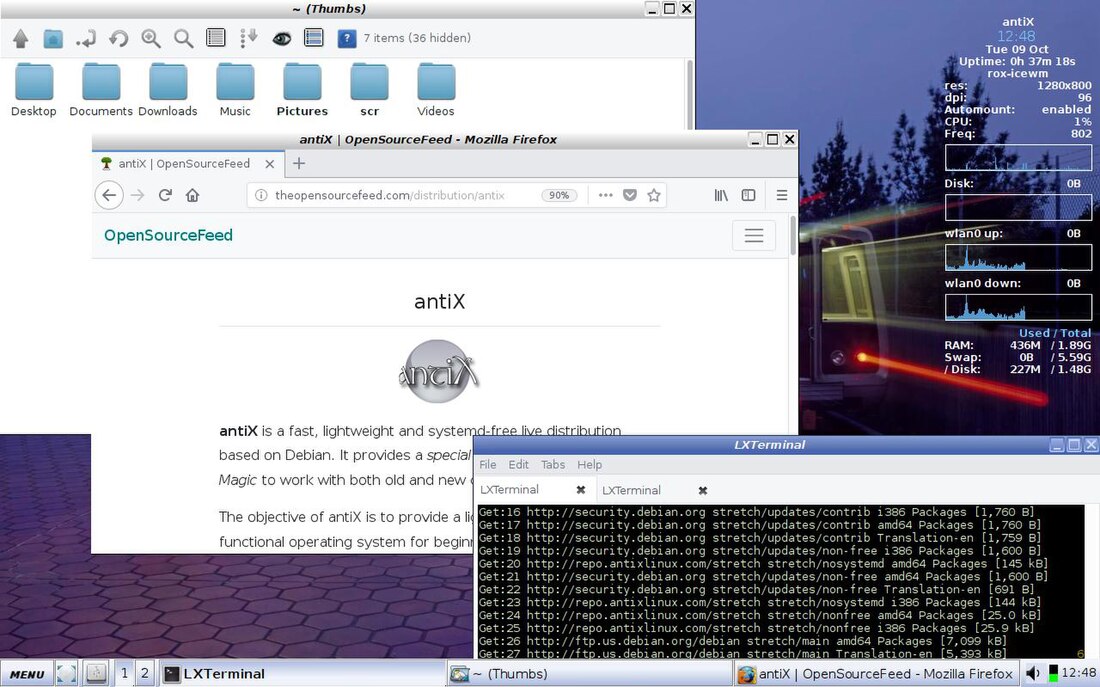Top Qs
Timeline
Chat
Perspective
AntiX
Lightweight systemd free Linux distribution From Wikipedia, the free encyclopedia
Remove ads
antiX (/ˈæntɪks/) is a Linux distribution, originally based on MEPIS, which itself is based on the Debian stable distribution.[4] antiX initially replaced the MEPIS KDE desktop environment with the Fluxbox and IceWM window managers, making it suitable for older, less powerful x86-based systems. Unlike Debian, antiX does not use the systemd init system; instead, it provides images in which either SysVinit or Runit are set as the default init system.[5]
Remove ads
Features
A lightweight distro well suited for older PCs including a 'Legacy' 5.10 kernel for older PCs and 'Modern' 6.1 kernel or more recent providing better hardware support.[1] Large app choice from both Debian and antiX repositories.[6] systemd and elogind free.
- Starting with version 19, antiX offers sysVinit and runit as a choice for the init system.
- Starting with version 22, antiX is offered elogind-free for both 32-bit and 64-bit architecture.[7]
- Starting with version 23.1, antiX has new apps: antiX TV, antiX Radio, Finder, antiX SAMBA manager, and several others.[8]
- Starting with version 23.2, antiX Full comes with two kernels: Legacy 5.10 and Modern 6.1.[1]
antiX has extensive support for "live CD" and "live USB" modes, booting quickly and running independently of the system's disk.[9]
Remove ads
Window managers
antiX comes with a default desktop built on top of the ROX or Zzzfm file managers, with the GTK library and using IceWM as the window manager.[10] antiX-full and antiX-base include these stacking window managers:
- Lightweight: Rox-IceWM (default), IceWM and ZzzFM-IceWM
- Minimalist: Rox-Fluxbox, Fluxbox and ZzzFM-Fluxbox
- Very minimalist: Rox-JWM, JWM[11] and ZzzFM-JWM
Running the ROX or Zzzfm variants provides desktop icons and a drag-and-drop function. Conky provides system monitor availability.
Remove ads
Versions
antiX is available for IA-32 (32-bit) and x86-64 (64-bit) architectures, and comes in four versions:[12][8]
- Full, Includes X, four window managers, LibreOffice suite, and a 'Package Installer' which allows installation of a full range of applications (1.7 GB)
- Base, Includes X, four window managers, and a 'Package Installer' which allows the user to choose their own application suite (1 GB)
- Core, No X, command-line installer without encryption, enables the user to have total control over the install (520 MB)
- net, No X, command-line installer without encryption, enables the user to have total control, no desktop environment by default (220 MB)
These four antiX versions were joined by MEPIS in 2014, developed in cooperation with the MEPIS community to form MX Linux.[13] MX Linux uses Xfce as the default desktop environment,[14] is based directly on Debian Stable, is highly stable and gives solid performance from a medium-sized footprint. Since November 2016, MX Linux is listed as a separate distro on DistroWatch.[15]
Releases
Summarize
Perspective
The releases of antiX are named after prominent left-wing figures, groups and revolutionaries.
Historical versions
Supported versions
Remove ads
See also
- Category:Linux distributions without systemd
- List of Linux distributions that run from RAM
- Light-weight Linux distribution
- MX Linux a distro based on Debian using core antiX components.
References
External links
Wikiwand - on
Seamless Wikipedia browsing. On steroids.
Remove ads

